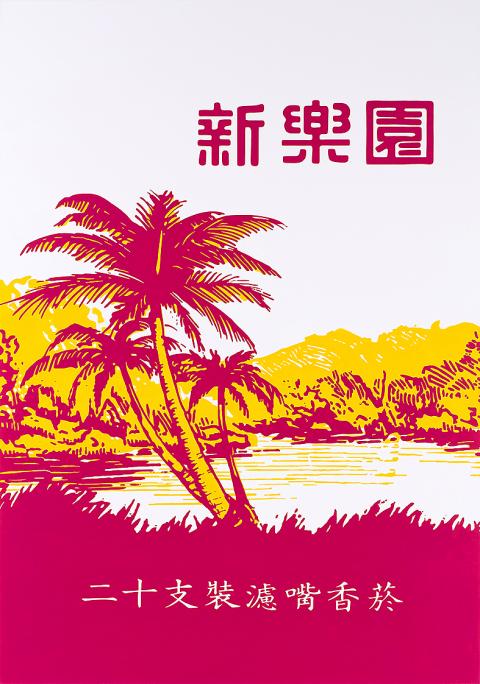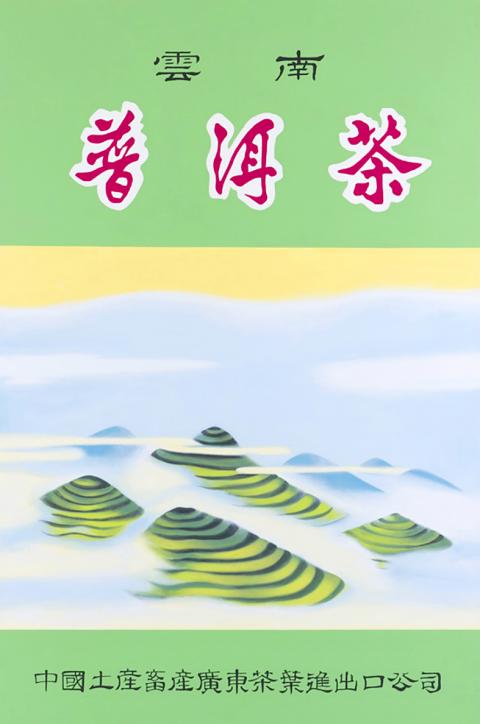Michael Lin (林明弘) strays from his usual floral motifs that cover entire gallery walls and buildings with his latest solo exhibition New Paradise (新樂園), held in Taipei’s Eslite Gallery. Instead, this series of paintings — made over the last 10 years during his residency in Shanghai — depicts consumer items such as the old logo for a pack of Taiwan’s New Paradise cigarettes (新樂園) or the packaging for Yunnan Puer Tea (雲南普洱茶). Lin, who has lived in Taiwan, France, Belgium, the US and China, considers both consumerism and locality in his work. Who are the types of people who purchase these items? How do these items that we consume contribute to our feelings of belonging or national identity?
■ Eslite Gallery (誠品畫廊), 5F, 11 Songgao Rd, Taipei City (台北市松高路11號5樓), tel: (02) 8789-3388. Open Tuesdays to Sundays from 11am to 7pm
■ Until Dec. 4

Photo courtesy of Art Issue Projects
Currently on display at MOCA is Polymerization & Multiply (聚合與繁衍). The joint exhibition features the works of video artists Robert Seidel and Max Hattler from Germany and Matt Abbiss from the UK. Seidel’s “moving paintings” — blotches of neon paint swimming against a black backdrop — are created through a series of scientific processes. Deriving inspiration from early 20th-century visual music experiments, Hattler plays with both sound and imagery, the result of which is kaleidoscope-like images bopping, morphing and changing form to various beats. Abiss’s work is somewhat less abstract. The pop culture junkie had a career as a cartoonist before delving into animation and his cute and quirky comics still feature in his animated clips.
■ Museum of Contemporary Art, Taipei (台北當代藝術館, MOCA, Taipei), 39 Changan W Rd, Taipei City (台北市長安西路39號), tel: (02) 2552-3720. Open Tuesdays to Sundays from 10am to 6pm
■ Until Dec. 4

Photo courtesy of Art Issue Projects
Chiu Chen-hung (邱承宏) makes use of the natural environment surrounding the Xindian River by Treasure Hill Artist Village for his latest exhibition. Named after the fast-growing weed, Mile-a-Minute Weed (河流砂) is a series of installations that explores the entangled relationship between humans and nature, as well as narrative structures — in particular, historical narratives. Native to Central America, the plant was introduced to Asia during World War II for the purpose of camouflaging airfield hangers. Chiu looks back at the history of Treasure Hill, most notably its use as a military base and how its inhabitants would later rebuild their lives there.
■ Treasure Hill Artist Village (寶藏巖國際藝術村), 2, Ally 14, Ln 230, Dingzhou Rd Sec 3, Taipei City (台北市汀州路三段230巷14弄2號), tel: (02) 2364-5313. Open Tuesdays to Sundays from 11am to 6pm
■ Until Dec. 4

Photo courtesy of MOCA
The Parisian-born Ivan Gros has lived a nomadic life, moving from France and Spain to Saudi Arabia and eventually to Taiwan in 2009 to study Chinese and teach French. His prints, inspired by his travels around the world, are on display at printmaking shop MBMore. 33 Tours (三十三座塔) includes a collection of Gros’ prints made during his time in Taiwan — mostly everyday depictions of people and families in scenes ranging from parks to construction sites, as well as iconic places like the hot springs in Taipei’s Beitou District (北投) and beaches on Orchid Island.
■ MBMore (岩筆模), 275, Nanjing W Rd, Taipei City (台北市南京西路275號), tel: (02) 2558-3395. Open Tuesday to Sundays from 11am to 7pm
■ Until Dec. 18

Photo courtesy of MBMore
On display at Art Issue Projects is Innercode vs Intercode (存在關係), a stellar lineup of works including Damien Hirst’s morbid sculptures, Marc Quinn’s psychedelic and suggestive paintings and South Korean artist Lee U-fan’s minimalistic-style paintings of blue lines. Lee was one of the pivotal figures in the development of the monochrome painting movement beginning in South Korea in the 1970s. The artistic style arose out of a need to reinterpret contemporary Western art through the lens of Korea’s own history and culture. The exhibition’s title alludes to a need to look deep within ourselves (“inner”), but also to see connections between ourselves and others and among different cultures (“inter).
■ Art Issue Projects (藝術計劃), 32, Ln 407, Tiding Blvd Sec 2, Taipei City (台北市堤頂大道二段407巷32號), tel: (02) 2659-7737. Open Tuesdays to Sundays from 11am to 6pm
■ Until Dec. 31

Photo courtesy of MBMore

Photo courtesy of Eslite Gallery

Photo courtesy of Eslite Gallery

Seven hundred job applications. One interview. Marco Mascaro arrived in Taiwan last year with a PhD in engineering physics and years of experience at a European research center. He thought his Gold Card would guarantee him a foothold in Taiwan’s job market. “It’s marketed as if Taiwan really needs you,” the 33-year-old Italian says. “The reality is that companies here don’t really need us.” The Employment Gold Card was designed to fix Taiwan’s labor shortage by offering foreign professionals a combined resident visa and open work permit valid for three years. But for many, like Mascaro, the welcome mat ends at the door. A

Last week gave us the droll little comedy of People’s Republic of China’s (PRC) consul general in Osaka posting a threat on X in response to Japanese Prime Minister Sanae Takaichi saying to the Diet that a Chinese attack on Taiwan may be an “existential threat” to Japan. That would allow Japanese Self Defence Forces to respond militarily. The PRC representative then said that if a “filthy neck sticks itself in uninvited, we will cut it off without a moment’s hesitation. Are you prepared for that?” This was widely, and probably deliberately, construed as a threat to behead Takaichi, though it

Nov. 17 to Nov. 23 When Kanori Ino surveyed Taipei’s Indigenous settlements in 1896, he found a culture that was fading. Although there was still a “clear line of distinction” between the Ketagalan people and the neighboring Han settlers that had been arriving over the previous 200 years, the former had largely adopted the customs and language of the latter. “Fortunately, some elders still remember their past customs and language. But if we do not hurry and record them now, future researchers will have nothing left but to weep amid the ruins of Indigenous settlements,” he wrote in the Journal of

If China attacks, will Taiwanese be willing to fight? Analysts of certain types obsess over questions like this, especially military analysts and those with an ax to grind as to whether Taiwan is worth defending, or should be cut loose to appease Beijing. Fellow columnist Michael Turton in “Notes from Central Taiwan: Willing to fight for the homeland” (Nov. 6, page 12) provides a superb analysis of this topic, how it is used and manipulated to political ends and what the underlying data shows. The problem is that most analysis is centered around polling data, which as Turton observes, “many of these